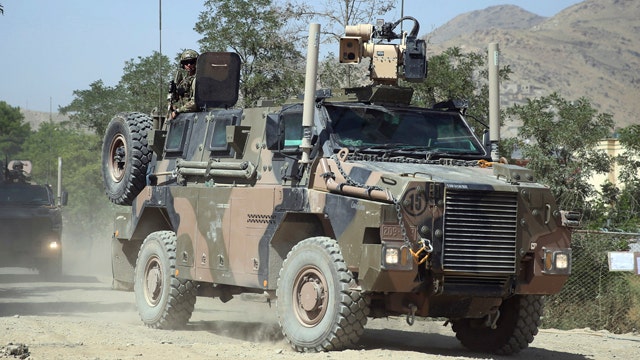At least 1 American dead in shooting at Afghan army base
Man wearing Afghan army uniform opens fire on foreign troops at military base
A man in an Afghan Army uniform opened fire Tuesday at a military base, killing a U.S. general and wounding 15 people, among them a German brigadier general and a number of Americans troops.
U.S. officials identified the murdered American late Tuesday as Maj. Gen. Harold Greene. Greene was the highest-ranked American officer killed in combat since 1970 in the Vietnam War.
Greene, who was on his first deployment to a war zone, was involved in preparing Afghan forces for the time when U.S.-coalition troops leave at the end of this year. An engineer by training, he was the deputy commanding general, Combined Security Transition Command-Afghanistan.
Pentagon spokesman, Rear Adm. John Kirby, said earlier that the assailant fired into a group of international soldiers at the Marshal Fahim National Defense University at Camp Qargha, a base west of Kabul, and was subsequently killed.
Another 15 people, roughly half of them Americans, were wounded. Among the wounded were a German brigadier general, two Afghan generals and an Afghan officer, whose rank the Afghan Defense Ministry did not provide.
The attack occurred during a site visit to the university by coalition members.
Ministry spokesman Gen. Mohammad Zahir Azimi said a "terrorist in an army uniform" opened fire on both local and international troops.
The Qargha shooting comes as so-called "insider attacks" -- incidents in which Afghan security turn on their NATO partners -- largely dropped last year. In 2013, there were 16 deaths in 10 separate attacks. In 2012, such attacks killed 53 coalition troops in 38 separate attacks.
Germany's military said 15 NATO soldiers were wounded in an assault launched "probably by internal attackers." The wounded included a German brigadier general, who the German military said was receiving medical treatment and was "not in a life-threatening condition."
NATO said it was investigating the attack, which Afghan President Hamid Karzai condemned as "cowardly."
It is "an act by the enemies who don't want to see Afghanistan have strong institutions," Karzai said in a statement.
Officials with the Taliban could not be immediately reached for comment.
Qargha is known as "Sandhurst in the sand"-- referring to the famed British military academy -- as British forces oversaw building the officer school and its training program. In a statement, the British Defense Ministry said it was investigating the incident and that "it would be inappropriate to comment further at this time."
Soldiers were tense in the immediate aftermath of the shooting. One soldier in a NATO convoy leaving Camp Qargha fired a pistol in an apparent warning shot in the vicinity of Associated Press journalists who were in a car, as well as pedestrians standing nearby. AP photographer Massoud Hossaini said he and an AP colleague were about 15 feet from the soldier at the time.
"The vehicle before the last one, someone shouted at me," Hossaini said. "The last one, the soldier opened fire."
No one was wounded.
Such "insider attacks" are sometimes claimed by the Taliban insurgency as proof of their infiltration. Others are attributed to personal disputes or resentment by Afghans who have soured on the continued international presence in their country more than a dozen years after the fall of the Taliban's ultra-conservative Islamic regime.
Foreign aid workers, contractors, journalists and other civilians in Afghanistan are increasingly becoming targets of violence as the U.S.-led military coalition continues a withdrawal to be complete by the end of the year.
In eastern Paktia province, an Afghan police guard also exchanged fire Tuesday with NATO troops near the governor's office, provincial police chief Gen. Zelmia Oryakhail said. The guard was killed in the gunfight, he said. It wasn't clear if the two incidents were linked and police said they were investigating the incident.
Meanwhile Tuesday, a NATO helicopter strike targeting missile-launching Taliban militants killed four civilians in western Afghanistan, an Afghan official said Tuesday. NATO said they were investigating the attack.
The attack in western Herat province comes as civilian casualties from NATO attacks remain a contentious issue across the country. Almost 200 people protested against NATO in Herat on Tuesday, carrying the bodies of the dead civilians into the provincial capital and demanding an investigation.
In a statement, NATO said it was aware of the attack and was investigating, without elaborating.
Civilians increasingly find themselves under fire as the 2001 U.S.-led war draws to a close, as Afghan forces take the lead in operations targeting the Taliban. The civilian death toll in the war in Afghanistan rose 17 percent for the first half of this year, the United Nations reported in July. The U.N. said 1,564 civilians were killed from January through June, compared with 1,342 in the first six months of 2013.
Insurgents were responsible for 74 percent of the casualties, the U.N. said, while pro-government forces were responsible for 9 percent, government forces 8 percent and foreign troops 1 percent. The rest could not be attributed to any group.
Karzai has repeatedly clashed with NATO over civilian casualties and strongly condemned the helicopter attack Tuesday.
Afghan security forces also increasingly find themselves under attack as the planned foreign troop withdrawal draws near. On Tuesday, a police car struck a roadside bomb in the eastern province of Nouristan, killing three officers, provincial police chief Abdul Baqi Nouristani said. Two other roadside bombs in northern Sari Pul province killed three people, including a district police chief and his driver, deputy provincial police chief Sakhi Dad Haidary said.
The Associated Press contributed to this report.

